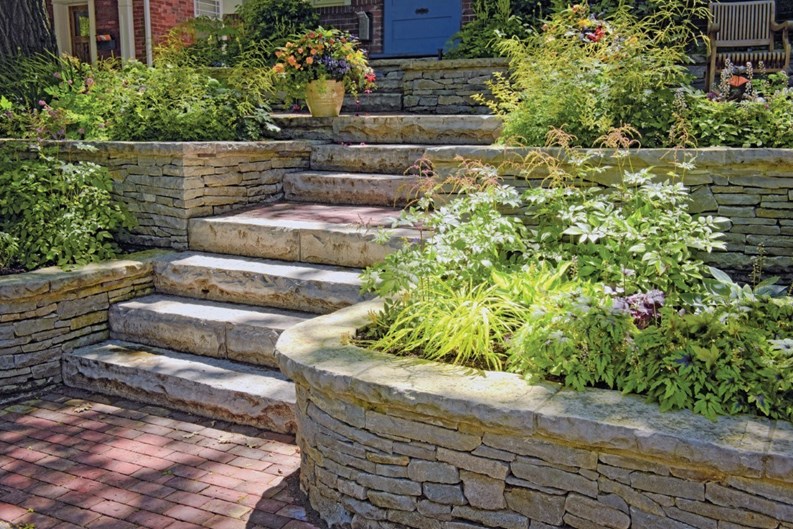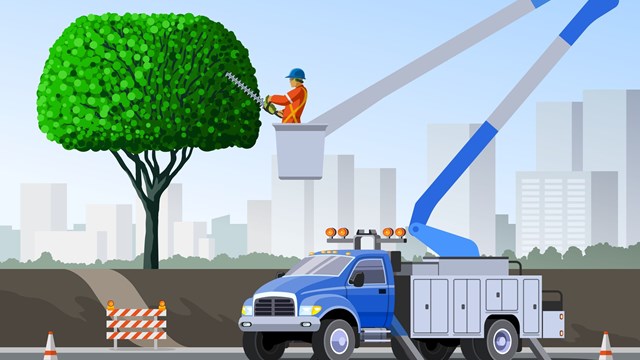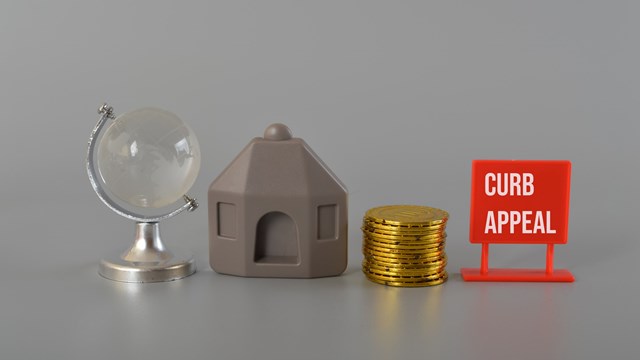When most people think of a condo’s landscaping, images come to mind of well-trimmed lawns, beautiful flowers or stately trees. But there is another part of landscaping that is just as important, but not as well known – hardscaping.
“Hardscaping is all the stuff outside that does not live,” says landscape architect Tom Ryan, owner of Ryan & Associates Landscape Architecture and Planning in Waltham, Massachusetts. While generally thought of as paving, walls and fences, hardscaping also includes “trellises, benches, trash cans, lights, pools, tennis courts and other amenities,” says Ryan. It’s also driveways, pagodas, barbecue pits, seating, lighting and gutters and drainage systems.
The materials in the hardscaper’s palette include asphalt, concrete, granite, metal, wood, and rubber (all of which have been improved radically in the last few years), as well as stones such as flagstone and bluestone, and bricks. “And paving can be as simple as dirt,” adds Ryan.
Budgeting for the hardscape can be fairly painless for a condo association when the improvement that will result is a more beautiful landscape.
“But some of it is structural stuff and not aesthetically pleasing,” says Roger Sturgis, owner of Roger B. Sturgis & Associates in Farmington, Connecticut, like “when it comes to solving drainage problems or putting up retaining walls.” Often renovationsare invisible, in fact, as in, “I just paid $50,000 and I don’t see the damn thing,” says Sturgis.
But that structural stuff keeps errant water runoff from damaging the infrastructure of the condominium, both outside and in. And, of course, it lays the foundation for the lovely, breathing “softscape,” the plant material, including perennial and annual plantings, trees, shrubs, gardens and verdant green lawns.
As for that nitty-gritty aspect of the hardscaper’s craft, “We often get called in when somebody’s unhappy,” reports Ryan. “It might be that they’re trying to upgrade all the units and the site looks just tired. Pavements and walls take a lot of abuse from snowplows, machines and moving trucks, so we go in and do renovations. We might be changing over paving that has failed, replacing it with a different type of material. It might be an asphaltwalk that has settled and we upgrade that material to a paver or brick.”
Or perhaps the softscape has picked a fight with the hardscape. “You see people put in trees that are five feet tall that grow to be 25 feet tall right next to a stone wall or too close to a driveway,” says Sturgis. “In five years the pine pitch from that tree is drippingall over your cars.” An overgrown tree could easily crack walkways and driveways. Note to the landscaping committee: plants and trees grow.
It’s not very satisfying to budget for those sorts of hardscaping jobs, Sturgisconcedes, “but if you don’t have the budget for it there are some negative consequences, like when your retaining wall collapses into a wetland.”
Other hardscape projects include fixing the causes of flooding, resurfacing an unsightly granite patio, replacing anugly retaining wall or fixing a crack in a stairway that causes puddles to form where the stairs meet the walkway.
Beautifying the Landscape
Beautification hardscape jobs range from minor spruce-ups to massive renovation of the outdoor space. The advantages of hardscaping abound. It can change the way residents and prospective buyers feel about the condominium.
“When you first pull into a place, the first thing you notice is the landscape,” says Ryan. “Before you even get out of your car, your feelings about the place have been established.” Changing the grounds outside of a home, say, the path leading to your entrance or the view from the window, can enhance the homeowners’ lifestyle, especially those who live in a condominium with250 units based on three floor plans.
“Does it feel like I am ‘unit 47B’ and there is no differentiation between47B and 47A?” asks Ryan. “You have to have to feel that this is both a neighborhood and a home. You do that with landscape. The hardscape and the planting both give you that variation for short dollars. It really makes for a much richer place.”
Hardscape can make the property more livable and usable, especially in larger condos with big outdoor space. “With patios, gardens and little balconies out back, you don’t notice that you are cheek-to-jowl with all your neighbors,” observes Ryan, “You get smaller-scale private spaces that are articulated by a fence or even just enough paving to set a table and a couple of chairs. It makes all the difference in livability.”
In addition to creating small spaces on common property, hardscaping can be laid to direct traffic, to control water runoff, to create privacy, to correct a grade, to add color or texture, or just jazz up the property –and, perhaps most important, to increase the value of the condo.
According to Nick DiBenedetto, co-owner of N.D. Landscape in Georgetown, Massachusetts, “Any properly-designed landscape area that adheres to good function and aesthetics, proper lighting, with spots to walk, drive, park, turn around, and softened with beautiful garden areas – I think the value is tremendous.” It adds 15 to20 percent more value, he estimates.
“Good fences make good neighbors,” quotes Ryan. A fence at eye level, aboutfive or so feet high can provide a comfortable, but not formidable, visual barrier. But, he adds, “good hedges do the same thing.” So which should you choose?
Hardscape vs. Softscape
“Plantings are more expensive, they take up more space and require more maintenance in the long run,” says Ryan, “but they have a little different look to them –not as hard edged.”
Maintenance is the key issue with softscape. If, say, you choose to plant alawn rather than cover outdoor space with decorative paving, says Sturgis, “it’s going to cost maybe $2,000 to $3,000 to put in an irrigation system, and for the next 20 years you’re going to have to pay $50 a week to mow it, and $400 year for fertilizer, which may involve pesticides, which might be against the town bylaws.” Local ordinances on water usage also need to be considered.
Hardscape is also easier to control. This business of plants growing can lead to unexpected consequences. “Say you want to put in a big maple tree,” cautions Sturgis, “you’d better know that in three years you’re going to haveevery squirrel in the neighborhood climbing onto your roof.”
Hard and softscapes have different lifecycles. “For the first five years or so all the plants are expanding,” says Ryan. “They tend to get better over time.” Meanwhile, “buildings depreciate from day one, they start to get worse.” In time they need patching, replacement or renovation.
Types of Hardscape Projects
If the condo association is performing a complete restoration, according to DiBenedetto, “the hardscape is the first step in the design process, to make sure you’re dealing with size and scope and traffic flow and functionality of that space.” Hardscaping projects, he adds, “are typically the first components built. They’re very invasive to put down, usually requiring heavy equipment. There’s a lot of foundation and basework, so it requires a lot of digging. Typically, the higher-skilled craftsman on the site installs the hardscapes.”
On a smaller scale, a beautification project that delivers a big bang for the buck is repaving. “An expensive pavement just brings the whole level up,” says Ryan. “You can use a rich material that will color your feeling for the whole rest of the space. We sometimes do projects where we’ll do a little bit of brick paving at the front door and maybe a little rosette or something that might be surrounded by asphalt or concrete.”
Brick or stone pavers are more expensive than poured concrete, but they provide natural beauty, according to Bill McGuinness, co-developer of Palmer Hill, a new 195-residence condominium community in Stamford, Connecticut that features many hardscape features like flagstone porches and stone patios.
McGuinness says he also prefers using brick and stone over concrete because “they will last longer. Good flagstone will last longer than concrete. Concrete tends to age and cracks alongthe edge. The older concrete gets the worse it looks. The older stone gets the better it looks.”
“It’s more of a long-term investment,” adds McGuinness, “but you’re not going to be replacing it as often. Concrete is poured in large slabs and if there is a settlement issue, and if it actually cracks, you have to replace the whole slab that you’ve poured. With stone and brick you can take one or two out to replace them. In the long term, in terms of lifecycle, I believe it’s cheaper to go with the stone and brick.”
But concrete has come a long way. Concrete pavers today come almost in any color, texture and pattern. Plus bothconcrete and asphalt can be colored, painted in the way tennis courts are painted, and pressed into interesting patterns. Rubberized pavers, the kind they use in playgrounds and walks, provide a rich, if more expensive, surface treatment.
Retaining Walls
Replacing retaining walls – structures built to stabilize hillsides and control erosion – is a common project. It entailsdigging up dirt and replacing it with crushed stone or concrete footing to create a suitable structure to hold the wall. It’s a job for an expert and often requires a structural engineer.
“A retaining wall is used to level the area where there was not a level area before,” says Sturgis, to create a flat landscape, perhaps reshape a lawn or eliminate a steep hill to make it easier to mow, or to create a flat plane for a play or outdoor dining area. “Also, if you put in a septic system, you might need to put in a retaining wall to createthe level space,” explains Sturgis.
Retaining walls take a lot of abuse in the severe Northeastern climate. “We replaced a wall in the spring that was built only two years ago,” recalls Sturgis. “It just fell over.” Water freezes, then when it thaws it saturates soil, putting pressure on a wall. It will pushthe wall right over if it is not properly constructed.
Landscape contractors need to be aware of drainage issues whenever laying ground cover or putting up a retaining wall, making sure the guttersare working to direct the water safely. “What happens if you have two feet of snow in winter and the ground is frozen, and then it rains in March and April?” posits Sturgis. “Where does the water go?” Unlevel ground can be a problem as well, allowing water to run into basement or ground level space. It needs to be re-graded, perhaps by building a retaining wall.
Besides eroding walls, frozen water can make the surfaces of the sidewalks, paths and driveways dangerously slippery. But some newly-developed porous asphalt and concrete pavers that allow water will soak through the pavement as opposed to run along the surface, eliminating frozen ground tops – “the kind lawyers really like,” quips Ryan. Porous pavers also help contain storm-waterwithin the property.
Stormwater Retention
The Department of Environmental Protection in each state has regulations that lay out the responsibilities for municipalities and private property owners for controlling stormwater. The state of Massachusetts’ DEP has proposed regulations that would require private property owners of impervious surfaces of five or more acres, including parking lots and roofs, to manage storm-water by adopting a variety of practices or installing devices to reduce pollution and the volume of water runoff.
These measures extend from regular parking lot sweeping to the installation of infiltration basins and rain gardens in large new developments and re-developments. Areas around Boston and the Charles River could be mandated to install permeable hardscapes that prevent stormwater from running off the property.
Large property owners and condominium association owners are concerned that the proposed new DEP regulations would shift an unfair burden, including installing expensive drainage systems, onto private owners and organizations. Their complaints are the primary reason the regulations were still in committee earlier this yearand were waiting to be voted on by the Massachusetts Legislature.
Trends in Hardscaping
Outdoor rooms are a popular amenity today, including outdoor kitchen areasand little park-like sitting areas with fireplaces. They are often placed right off the pool area, if there is one, or right outside an indoor common area to give the area an expansive feel.
The green revolution has hit landscaping, too. Manufacturers are developing lines of pavers made with recycled materials, glasses and aggregates containing recycled brick.
New technology has produced fences and trellises made of new composite materials using plastics and vinyls that do not rot. Also, composites containingsawdust or wood, often used in the trims of buildings, have become invaluable in hardscaping. Recycled woods are often used on decks.
Some contractors favor artificial wood for decks, fences and trellises forits durability. Plus, a new processed wood from Scandinavia is made without the arsenic and other problematic chemicals that were traditionally used to treat and preserve wood.
The newest development in walls is interlocking wall units, used for retaining walls especially, but also for freestanding walls. Offered today in a variety of colors, “in small areas, if theyare designed right,” says Ryan, “they can look pretty good and can be fairly economical for a retaining wall.”
LED lights have stormed the landscaping field, allowing designers to put highly efficient but tiny light fixtures in walkways and gardens, where before there might have used immense, trashcan-size fixtures. Also today, most outdoor lighting is “dark sky compliant,” focused downward so as not to contribute to “light pollution,” the kind that obscures the urban sky of stars at night.
“This is Fantastic”
When associations consider renovations to the landscaping, there is oftena strong objection by some members of the board due to its potential cost.
But after installing new hardscaping and having laid the softscape to complement it, perhaps a fresh new lawn, says DiBenedetto, “compared to what they were used to – a drab, dusty, dirty area – a lot of my clients say, “my God, this is fantastic.”
Steve Cutler is a freelance writer and a frequent contributor to New England Condominium magazine.







Comments
Leave a Comment